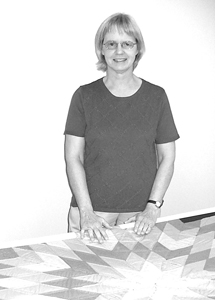AROUND THE FRAME
 Common Threads: Amish Quilts from the Pottinger Collection
Common Threads: Amish Quilts from the Pottinger Collection
Go to the Fort Wayne Museum of Art to see the Pottinger Collection of Amish quilts. This weekend is your last chance to view it. Sunday is a free admission day too, from noon – 5 p.m.
In 1977 David Pottinger buys a general store in Honeyville (Lagrange County) Indiana where he serves the needs of the local Amish community. He begins to purchase quilts made between 1870-1940 from the makers or their descendents. He documents the makers and their quilts creating a volume of information conducive to quilt history and research. In 1983 his book Quilts from the Indiana Amish is published. His collection grows to 700 quilts and a number of them are purchased by the Indiana State Museum and can be viewed on-line at:
www.indianamuseum.org/
In 1992 the Fort Wayne Museum of Art purchases 55 quilts from his collection, the first textile collection ever purchased by the museum. It is an important collection representing Northeast Indiana Amish quilts from a specific time period.
My visit is a double treat, not only do I view these colorful geometric quilts, it is my first visit to FWMoA since it was enlarged. Entering the gallery I am greeted by security guard and IPFW art major Scott McCaffrey. Scott cautions me to use pencil, not a pen while taking notes in the gallery. Touching the quilts is strictly verboten.
I ask and receive permission to photograph a quilt for this article. As I walk around, taking them all in, Scott informs me he has enjoyed looking at them over the past weeks.
Most people identify Amish quilts by their plain colors, use of black and their simple geometric designs. I like looking at quilts as both a forest and a tree. The forest view from afar shows the striking vivid colors and how they would look on the clothesline.
Examining them up close, I point out to Scott how a museum conservator expertly placed a sheer mesh over damaged areas. Only when the light hits it can we see how this was applied as a means to keep the damage from becoming worse. I show him how certain quilt motifs are evident in many of the quilts; the “wreath” in plain squares and cables in borders.
After viewing them all, I make my decision which one to photograph. It has characteristics different than the others, yet at first glance you don’t notice the differences. What you do notice is it’s knock-out color scheme. Mrs. Jerome Hochstetler made this four-patch Diamond in a Square quilt around 1935. The quilt has four borders, more than any other quilt on display. The bound edges are scalloped where all of the others are straight-edged except for the small wedding ring quilt exhibited next to it which naturally doesn’t have a straight-edge. The binding is green, a color not found on the front of the quilt. Most, if not all, of the other quilts’ binding color is found on the quilt. Perhaps this quilt is bound to match the back. I didn’t dare touch it to look.
Mrs. Hostetler used sateen cotton which gives the quilt a shiny look. She uses two different shades of black in the squares and moves them around the blocks making your eyes move with them. The quilt is wonderfully hand-stitched. The hearts inside the diamonds are quilted down the middle, making them appear to be broken.
Do plan to spend some time at the museum. Beside the quilts there are related exhibits of dolls and sewing accessories. The gift shop sells quilts related items.
Lois Eubank has been restoring quilts for over twenty years. Her studio is located in downtown Fort Wayne. For more information visit go to www.bornagainquilts.com.
- The Stars & Stripes Are Forever: Around The Frame - July 5, 2024
- Sam Butcher: A Life Filled With Precious Moments ~ Around The Frame - June 7, 2024
- Aunt Dora & Her Well-Lived Life ~ Around The Frame - May 10, 2024

